100th Anniversary Great Nave Tour at the Cathedral of St. John the Divine
Celebrate the 1925 construction of the stunning nave inside the world's largest Gothic cathedral!


When most people think of the words “sex” and “museum” in the same sentence, they think of the Museum of Sex or the often joked-about Icelandic Phallological Museum. However, if you want to see a really sexy collection, you can just meander through our city’s magnificent — and stodgy — Metropolitan Museum of Art. This is the case because until the advent of photography in the mid-19th century, art was the only porn there was, and there are a lot of sexy images in the museum, from the ancient Greeks (masturbating monkeys, anyone?) to a very large pre-Impressionist canvas of a woman having an orgasm (see below).
Today, people mostly walk right by these pieces. Some of this is because the erotica is either veiled or at most, soft-core. Some is because we are taught from an early age to take art seriously, as artistic expression of profound truths — so we ignore its sexiness even when it’s in front of our noses. A lot, however, is because nobody lets you in on the sexy secrets — the scandalous backstories that would bring the museum’s masterpieces to life for us.
So to make amends on behalf of art history, we offer the following sexy pieces from the Metropolitan. For more quirky facts about New York City’s iconic museum, Shady Ladies Tours offers events with sex-and-gender themes, e.g. the Shady Ladies tour of the Metropolitan (courtesans and royal mistresses), the Nasty Women of the Metropolitan (ambitious and powerful women), the Hidden Secrets of the Metropolitan (scandalous backstories) and more.
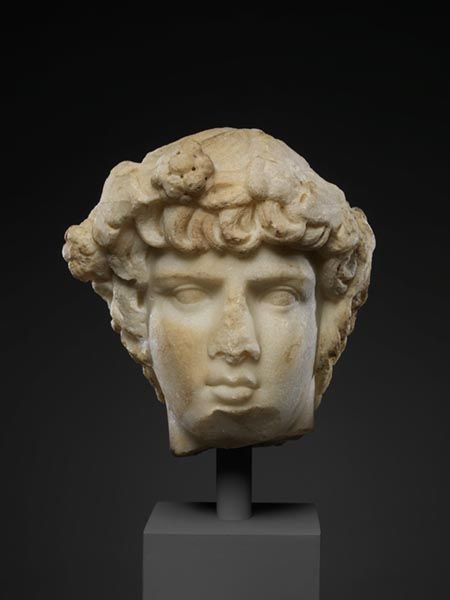
Marble portrait head of Antinoos. Photo from the Metropolitan Museum of Art in public domain
Antinoos was the lover of the Roman Emperor Hadrian although we don’t know much about the actuality of their relationship. Hadrian was 35 years older than Antinoos — typical for ancient Greece and Rome. But how old they were when they met or began their relationship, we don’t know. The only thing we ever hear about their time together is a story of a lion hunt in Egypt.
Their relationship became more interesting (for us in any case) when Antinoos died, by drowning in the Nile, at age 19. Again, the details of this event is murky: we do not know how it happened, but what’s interesting is how Hadrian reacted: he had Antinoos declared a god. This was not a usual occurrence: emperors generally became gods when they died, but no other kept boy did. This is why we now have over 100 marble busts and statues of Antinoos today — and how nice of the Met to put him right across from Hadrian!
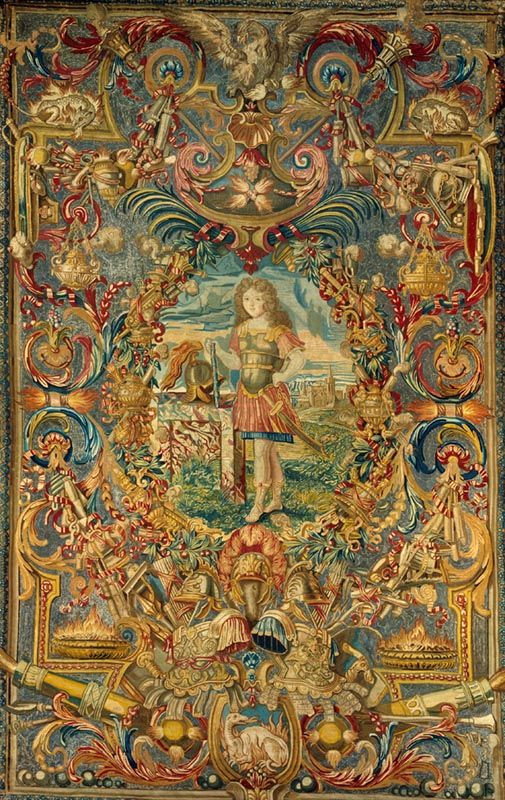
Seasons and Elements (Fire) (set of four). Photo from the Metropolitan Museum of Art, in public domain
These wall hangings are the glory of the Met’s Louis XIV period room. But who are the people represented on them? The man on the cloud to the left is easy to identify: the cloud and lightning-bolts make him Jupiter, but the big hair suggests that he is Louis XIV *as* Jupiter. Surprisingly, the woman on the right is not the queen, but Louis’ second major mistress, Athenaïs de Montespan, for whom the wall hangings were made, and the boy in armor to her right is their second son, Louis César (the Comte du Vexin after Louis legitimized and ennobled him).
Madame de Montespan, beautiful and tempestuous, was the most colorful of Louis’ mistresses. During the vast Affair of the Poisons that convulsed Paris from 1677 to 1682, she was accused of participating in black masses, with dead babies cut open over her naked body to distill poisons for the king. The accusations seem unlikely, frankly, because while many were executed, exiled, or sent to the galleys in the affair, nothing happened to Madame de Montespan at all. But it does seem likely that she at least visited the witch in question, if only to get aphrodisiacs, since she was on the verge of losing the king’s affection to their children’s governess, the king’s third and final major mistress, Madame de Maintenon.
 Marcantonio Pasqualini (1614–1691) Crowned by Apollo. Photo from the Metropolitan Museum of Art in public domain
Marcantonio Pasqualini (1614–1691) Crowned by Apollo. Photo from the Metropolitan Museum of Art in public domain
On the whole, the crowds in the Metropolitan gather around works by famous artists, but there are exceptions. This painting by Andrea Sacchi is one that catches people’s eye —probably because a big nude male is in the middle: male nudity is common in sculpture, but not in painting. Furthermore, this is a particularly arresting nude, because although obviously male, his languidly exaggerated contrapposto and puffy hairless body make him seem effeminate; his face is particularly gender-ambiguous.
Finally, there is the fact that his privates are almost in the compositional center of the painting — which is very unusual. But the nude is actually not the center of the painting’s message: the nude is the god Apollo, and he is crowning someone, clearly the subject of the portrait: Marcantonio Pasqualini, one of the great castrato singers of Baroque Rome. This probably explains the central position of the god’s genitalia, as there is an implicit contrast between the god, who has an intact manhood, and Pasqualini, who doesn’t. If that isn’t enough for you, this is not only a painting of a castrato that emphasizes his castration, it was also commissioned by his patron and probably lover, the Cardinal Antonio Barberini.
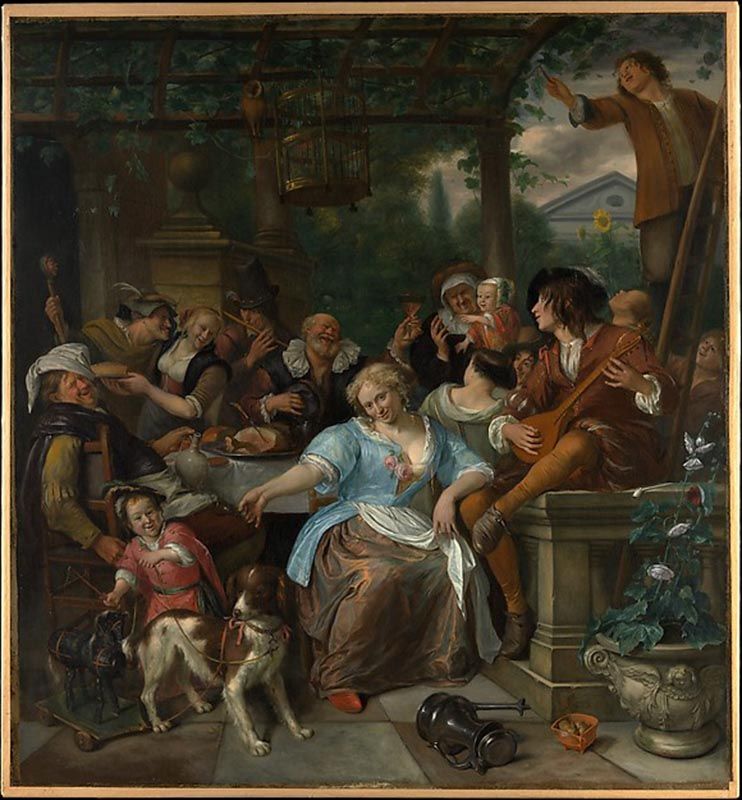
Merry Company on a Terrace. Photo from the Metropolitan Museum of Art in public domain.
This painting by the Dutch painter Jan Steen represents a party on a terrace, presumably of a tavern. A jokey, sexy tone dominates, as is made clear by the joker sticking his tongue out at the waitress in the background in a lascivious way: her response is merely to dodge his tongue and laugh at his antics.
The raciness in the foreground is just a little more subtle. The woman in the center of the foreground (the mistress of the tavern?) looks directly and slyly at the viewer. Her blouse, with pink roses (the flower of love at that time) pinned to it, is open, and her breasts are heaving into view. The drained wine glass that she holds casually in her right hand also seems suggestive — as perhaps does her gesture of lifting her apron to the side. Note also that she is casually resting her elbow on the thigh of the lute-boy to her left — and his lute juts out of his lap at a very suggestive angle. Works like this in Dutch painting are often seen as conveying a moral warning, but it’s hard to tell what the warning is here: the painter seems to revel instead in the scene of implied debauchery.
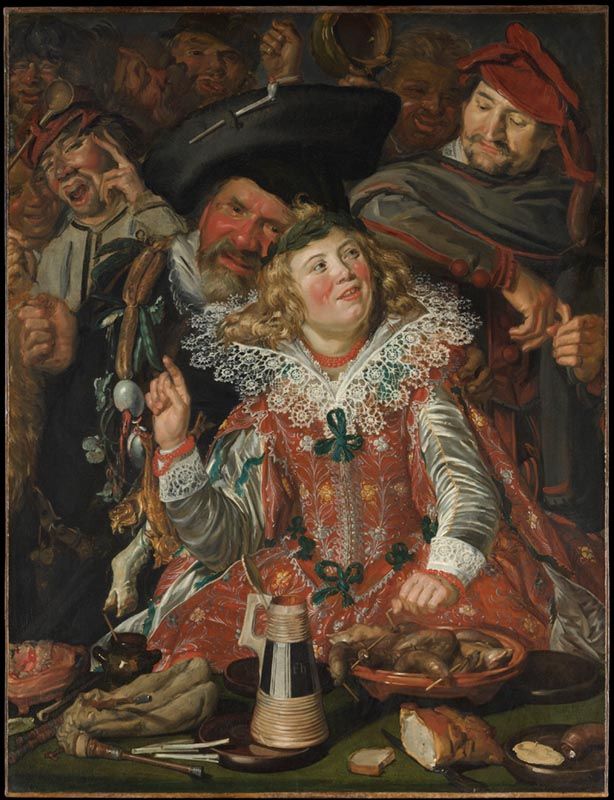
Merrymakers at Shrovetide. Photo from the Metropolitan Museum of Art in public domain
Another racy Dutch painting, by Frans Hals, is of “Shrovetide Revelers” (i.e. Mardi Gras partiers). Two men in clown costumes are leaning on the shoulders of an elaborately dressed or costumed maiden. The man on the left makes a sexy gesture, while the sausages hanging over the shoulder of the one on the right also seem suggestively phallic (like the deflated bagpipe on the table in front of them, and the bowl-full of remarkably phallic sausages).
But wait: is that really a maiden? Hint: he has an Adam’s apple! It is in fact a cross-dressed boy; perhaps his declamatory gesture identifies him as a boy actor, possibly one of the boy actors who in that time played female roles in the theater. In any case, the men around him seem to want him to play a queen off-stage as well….
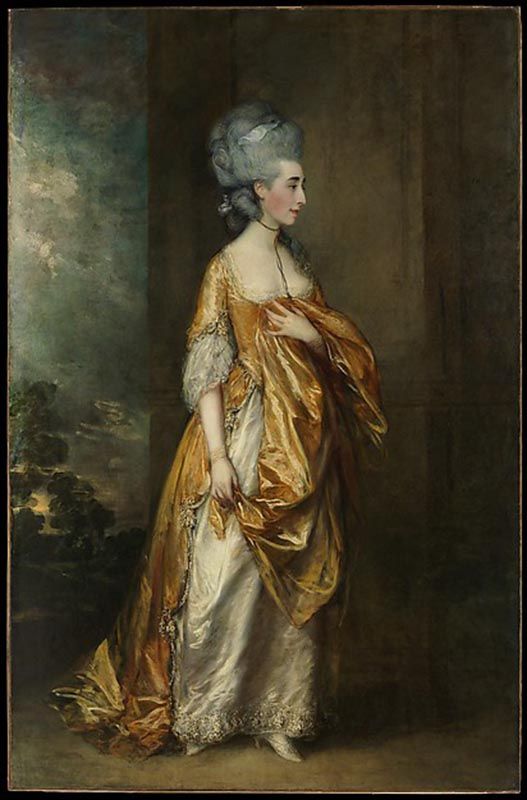
Photo from the Metropolitan Museum of Art in public domain
This stupendous portrait by Gainsborough seems to be of a princess: the woman wears an elegant gown of gold cloth trimmed with silver thread and carries her train demurely in front of her; she also sports a foot high powdered wig-like hairdo, in the style of Marie Antoinette’s court.
In fact, the subject, Grace Dalrymple Elliott, was a friend of Marie Antoinette’s, but she was a high class courtesan, and the portrait was paid for by her principal patron, the Marquess of Cholmondeley. Was Grace really this perfectly elegant? She might have been. Unlike most courtesans, who were generally the daughters of prostitutes/courtesans or born poor, she was born into the upper classes and came to her profession through a failed marriage. She also was mistress to some extraordinarily high-ranking men: not only Cholmondeley, but the Prince of Wales (the future George IV) — to whom she may have borne a daughter — and the Duc d’Orléans, who was second in line of succession in France. In fact, the portrait is less racy than many of aristocratic ladies of this period — though the long string leading to a locket hidden in her well-concealed bosom may hint at its famous ampleness….
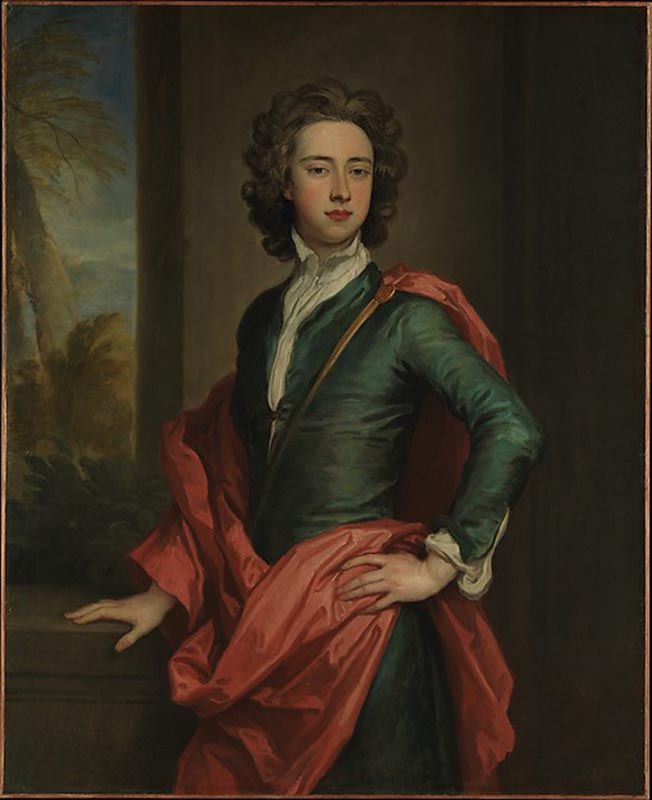
Charles Beauclerk (1670–1726), Duke of St. Albans. Photo from the Metropolitan Museum of Art, in public domain.
This is the kind of portrait that most people just glance at as they look for portraits of more famous people or by more famous painters. Who is the sitter, Charles Beauclerk, Duke of St. Albans (etc.), or the artist, Godfrey Kneller?
This portrait is actually of a royal bastard. Beauclerk was the son of King Charles II and his most popular mistress, the actress/celeb Nell Gwynn. Beauclerk himself is otherwise not too interesting, although his portrait presents interesting evidence for a shift in views of gender between the 17th century and today: to our eye, the subject’s haughty stance looks queeny, and his delicate skin and primped hair look effeminate — while to 17th century eyes, this was an aristocratic rake, ready perhaps to run you through with his rapier. But there is much more to say about his mother. Probably the most fun story about her is that once, when caught in an anti-Catholic riot—because the mob had mistaken her carriage for that of another royal mistress, who was a Catholic — she leant out of her carriage and said “pray, good people, be civil: I am the Protestant whore!” In any case, this painting is also a good reminder that there are scandalous backstories behind many works in the museum, even apparently respectable British portraits.
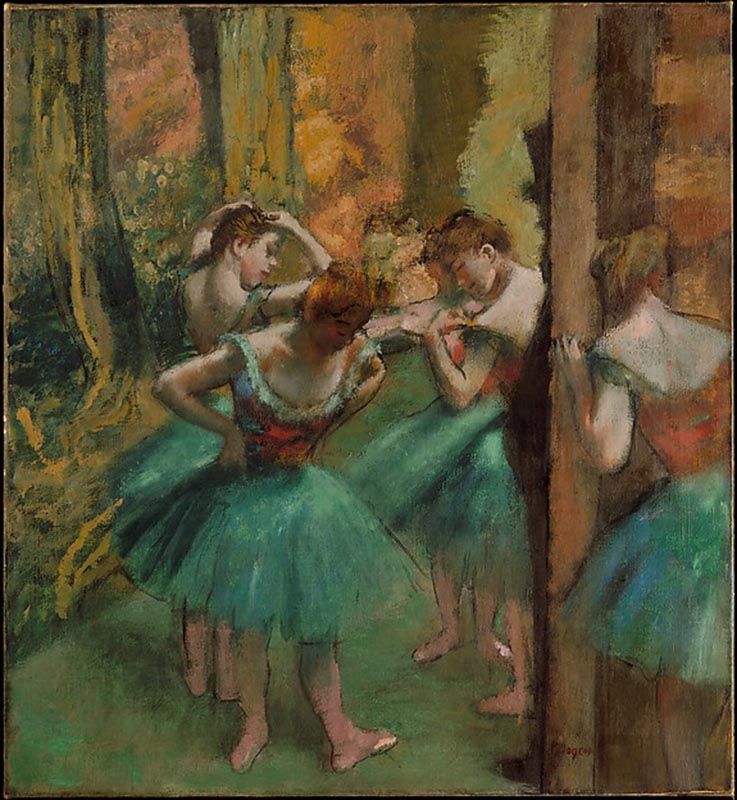
Dancers, Pink and Green. Photo from the Metropolitan Museum of Art in public domain.
Many young dancers grow up with Degas’ paintings of ballerinas hanging over their beds. But there are aspects of a 19th century ballerina’s life that parents would not want their kids to hear about because a career in ballet was not an option for a respectable, bourgeois girl in 19th century France.
Bourgeois girls were never going to get up on a stage and show their legs to all of Paris. Ballerinas were instead poor girls, chosen for their beauty and talent. In short, they were chosen for the same qualities that made a high-class courtesan. The ballet, furthermore, like all work for women at that time, paid poorly: a ballerina was supposed to find a man to support her— if possible to become the mistress of someone wealthy. People today are unaware of this whole system, but Degas of course was not: he was one of the wealthy men who patronized the ballerinas, although we don’t know if he wanted services other than posing. In any case, Degas puts the patrons in his paintings frequently. In this particularly beautiful painting of ballerinas adjusting their pink and green costumes, a man is just behind them, in the shadows. Modern viewers often don’t even notice him, and once they do, he looks sinister to our eyes. But he has two clear signs of wealth — a top hat and a pot belly — so he should be taken just as a gentlemen hanging out with the ballerinas, either as the patron of one of them, or on the look-out for a new mistress….
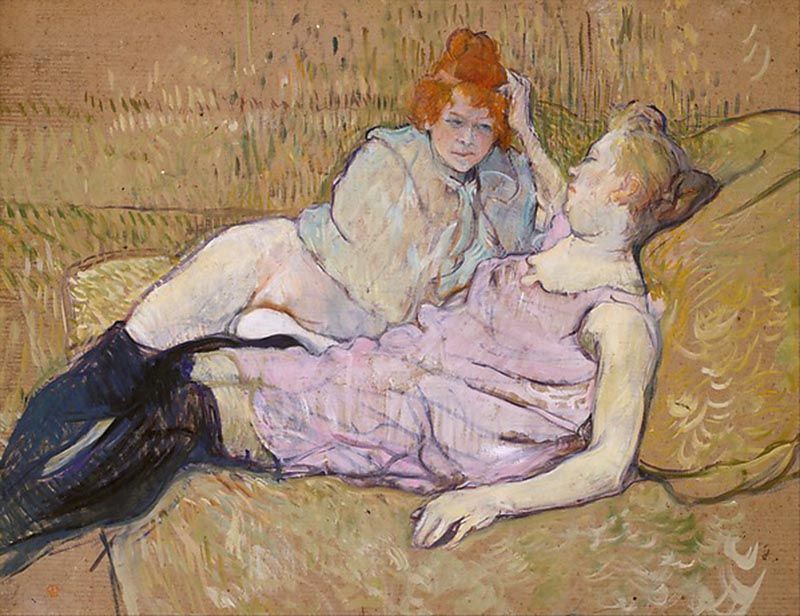
Photo from the Metropolitan Museum of Art, in public domain.
Fancy courtesans have been a theme in the high art of many cultures and cultural moments, from ancient Athens to Edo-period Japan to Renaissance Italy and so on. Prostitutes —women paid for specific sex acts, often employed in bordellos — are rare in world art. This painting by Toulouse-Lautrec — called, obscurely, “The Sofa”— is one of the great works on the theme, depicting two fatigued and rumples prostitutes in conversation; one could almost say they are communing with each other.
They are also evidently lovers, as the one on the left is nude from the waist down — and lesbianism is also a huge theme in Toulouse-Lautrec’s work, and was generally seen as trendy in French culture of the late 19th century. This is why so many American lesbians, including most famously Gertrude Stein, gravitated to Paris. The fancy courtesans were often said to be having lesbian affairs; at least according to Toulouse-Lautrec, so were the whores in the bordello….
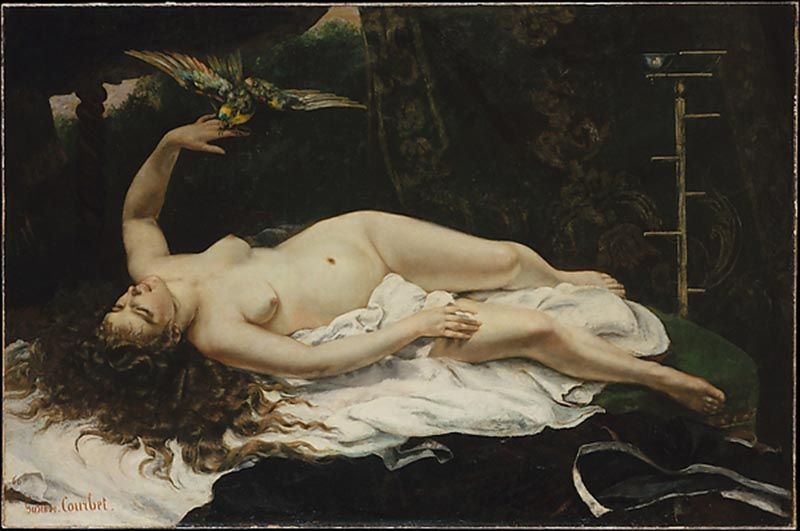
Woman With a Parrot. Photo via the Met
We have had whores, courtesans, mistresses, a boy toy, a drag artist, a castrato, a gay Cardinal. Let’s finish with a woman having an orgasm. Courbet was the bad boy of 19th century French art: he scandalized the establishment with everything from his political activities to his depiction of women, which were considered scandalous for their realism. This famous canvas is actually quite air-brushed by Courbet’s standards: we do not see, as so often in his work, cellulite or pubic hair. And the painting was more successful than most of his work: it was accepted by the Salon, and though it was controversial, the Ecole des Beaux Arts tried to buy it for its house collection.
However, if you look carefully, you will see that it is really just as scandalous as his other paintings of women: the flushed color of the subject’s cheeks, her odd smile, her erect nipples — everything points to an orgasmic or at least post-orgasmic state. It is also possible that the parrot she is playing with is a kind of phallic symbol: ‘oiseau’ in French is a word for ‘penis’, just as ‘bird’ (also ‘cock’, ‘pecker’ etc.) is in English. Indeed, this is a very rare painting, one of the only scenes of female sexual excitement you will ever see in a museum! It is almost funny how prominently the Metropolitan displays it — and how few people seem to notice that it’s not just another one of the museum’s many nudes…

Next, check out the Top 10 Secrets of the Metropolitan Museum of Art and The NYC that Never Was: The Metropolitan Museum of Art’s Unfinished Areas.
Subscribe to our newsletter